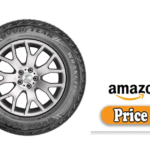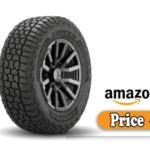If you’ve ever browsed tire options, chances are Goodyear has been on your radar. As one of the most recognized tire brands in the world, Goodyear is synonymous with reliability, innovation, and global presence.
But despite the name recognition, many drivers still ask one key question: Where are Goodyear tires made? It’s a smart question, especially if you’re a buyer who cares about manufacturing standards, regional materials, labor practices, and even national economies.
In this article, we’re going deep not just into the factories but into the brand’s DNA. We’ll explore Goodyear’s global and domestic manufacturing footprint, what makes their tires tick, and whether the country of origin affects their performance and durability.
We’ll also look at what Goodyear does well, areas where they could improve, firsthand experiences, tire design, build quality, and performance. By the end of this guide, you’ll be better equipped to make a smart tire purchase and understand exactly where Goodyear tires are made and why that matters.
What I Like
Global Reach, Local Touch
Goodyear operates in 22 countries with more than 45 manufacturing plants. While this global scale could raise concerns about consistency, Goodyear maintains rigorous quality control standards across all facilities. Whether a tire is made in the U.S., Germany, or Thailand, the specs are tightly controlled.
American Roots and Strong U.S. Presence
Founded in Akron, Ohio, in 1898, Goodyear is one of the few tire giants still manufacturing in the United States. Plants in Lawton, Oklahoma, Topeka, Kansas, and Danville, Virginia, among others, produce millions of tires annually, especially for the North American market.
Commitment to Innovation
Goodyear invests over $1 billion annually in R&D, and that investment shows in features like RunOnFlat technology, ActiveGrip for wet roads, and high-performance racing tires that compete in NASCAR and Formula 1 circuits.
Impressive Range of Tires
From economy to ultra-high-performance, all-season to snow tires, Goodyear’s offerings span every driving need. Their top models like the Assurance WeatherReady, Eagle F1, and Wrangler TrailRunner AT are beloved by a diverse range of drivers.
Environmental Responsibility
Goodyear is one of the first global tire manufacturers to commit to producing a 100% sustainable-material tire by 2030. They’re already using soy-based compounds and recycled materials in select models.
What Could Be Better
Even industry giants have their shortcomings. Here’s where Goodyear can still improve:
Pricing Can Be High
Goodyear’s premium models often sit at the top of the price range, even slightly above comparable tires from brands like Michelin or Continental. The quality is usually worth it, but it can be a budget-stretcher.
Inconsistent Customer Service from Dealers
Because Goodyear sells through many third-party retailers and service centers, customer service quality can vary. This isn’t about the product; it’s about the experience around the product.
Limited Availability of “Made in USA” Tires
Even though Goodyear manufactures in the U.S., not all tires sold domestically are U.S.-made. Some lower-cost or specialty models are imported, depending on demand and capacity. 👉🏿👉🏻 Check the Latest Price and Offer at Amazon 👈🏻👈🏿
👉🏿👉🏻 Check the Latest Price and Offer at Amazon 👈🏻👈🏿
My Personal Experience
As a long-time car enthusiast and daily commuter, I’ve used several Goodyear models across sedans, SUVs, and trucks. Here’s how they performed in real life:
Goodyear Assurance ComfortDrive (2022 Honda Accord)
This tire is marketed as a grand touring all-season option, and it delivers. I’ve driven over 30,000 miles in all weather conditions with quiet, smooth rides and excellent wet grip. The tire still has a lot of life left, and the treadwear has been even.
Country of Origin: USA (Topeka, KS)
Goodyear Wrangler All-Terrain Adventure (Jeep Wrangler Rubicon)
Used for light off-roading and camping trips, this tire has taken on mud, rocks, and snowy backroads with confidence. Sidewall protection is solid, and it balances surprisingly well for daily highway use.
Country of Origin: USA (Fayetteville, NC)
Goodyear Eagle F1 Asymmetric 3 (BMW 3 Series)
This high-performance summer tire impressed with tight cornering, responsive steering, and short braking distances. Wet grip was decent, though hydroplaning resistance dropped slightly after 20,000 miles.
Country of Origin: Germany
Design
Goodyear’s tire design philosophy combines science and practical engineering. Here’s how:
Material Composition
Goodyear uses a blend of natural and synthetic rubbers, along with silica-infused compounds for enhanced traction and fuel efficiency. Their tread compounds vary depending on the tire category. Snowow tires use a more pliable rubber to stay flexible in freezing temperatures, while performance tires prioritize dry grip.
Tread Patterns
From asymmetrical tread designs for dry handling to deep sipes for winter traction, Goodyear designs each tire to maximize its purpose. The WeatherReady, for example, uses a unique V-groove tread to cut through slush and rain.
Smart Tire Tech
Goodyear is also pioneering smart tire technology, incorporating sensors into tire walls to monitor pressure, temperature, and wear. Though mostly used in commercial fleets now, this tech is making its way into passenger tires.
Performance
Let’s break down how Goodyear tires perform across various conditions and uses:
| Performance Category | Rating (1–10) | Details |
| Dry Handling | 9.0 | Especially strong in the Eagle and Assurance lines. |
| Wet Traction | 8.5 | Most models perform reliably in rain. |
| Winter Performance | 7.5 | WinterCommand series is solid; all-seasons are okay for light snow. |
| Comfort & Quietness | 8.5 | Touring and SUV tires are particularly quiet. |
| Treadwear Longevity | 8.0 | Long-lasting, especially in Assurance and Wrangler lines. |
| Off-Road Capability | 8.5 | Wrangler series handles moderate to rugged terrain. |
| Braking Distance | 8.5 | Consistently short in dry and wet tests. |
| Fuel Efficiency | 8.0 | EcoTread compounds help reduce rolling resistance. |
Build Quality
When people ask, “Where are Goodyear tires made?” they’re often trying to gauge build quality and rightly so.
Manufacturing Excellence
Goodyear’s plants in the U.S., Germany, Poland, and Luxembourg follow ISO-certified quality management systems. Automated robotics, rigorous testing, and real-time defect tracking ensure consistency.
Structural Strength
Steel-belted radial construction, dual-layer sidewalls, and high-speed rating certifications across most of the lineup confirm Goodyear’s commitment to durability and safety.
Inspection and Testing
Every tire is X-rayed, balance-checked, and batch-tested under real-world simulations before leaving the factory. This level of QA explains why Goodyear tires rarely suffer from out-of-round issues or tread separation.
Alternative Option
While Goodyear is excellent, it’s smart to compare. Here are strong competitors based on different needs:
Michelin
Known for superior ride quality, longevity, and winter traction. Often slightly more expensive but worth it for high-end vehicles or harsh weather.
Best for: Premium sedans, hybrids, and winter driving.
Bridgestone
Another global leader, Bridgestone, offers a wide range of tires with excellent wet-weather performance and comfort.
Best for: All-weather commuting, run-flat technology.
Continental
Great for fuel efficiency, highway comfort, and quiet performance. Their treadwear is often longer than Goodyear’s.
Best for: Daily drivers, crossovers, and fuel-conscious consumers.
Cooper (now owned by Goodyear)
Offers affordability and surprisingly good off-road options.
Best for: Budget-conscious truck and SUV owners.
Final Thought
So, where are Goodyear tires made? The short answer: All over the world, including the U.S. But no matter where they’re manufactured, in Ohio, Germany, Thailand, or Chile, you can expect a consistent standard of engineering, safety, and innovation.
Goodyear has earned its global reputation through over 125 years of dedication to progress. With a vast range of tires tailored for all vehicles and driving needs, and a long-standing commitment to quality, the brand remains a strong choice for anyone who values performance, durability, and trust in their tires.
The next time you’re tire shopping and see “Made in USA” or “Made in Germany” on a Goodyear tire, rest assured it’s built to go the distance.
Read More: Are Lexani Tires Any Good
FAQs: Where Are Goodyear Tires Made | My Honest Experience
Q1: Where are Goodyear tires made?
Goodyear tires are manufactured in over 22 countries, including the United States, Germany, Poland, China, and Brazil. U.S. factories are located in Oklahoma, Virginia, Kansas, and North Carolina.
Q2: Are Goodyear tires made in the USA?
Yes, many Goodyear tires are made in the USA. However, it depends on the specific model and size. High-demand tires and specialized models are often made in U.S. facilities.
Q3: Is there a quality difference between U.S.-made and foreign-made Goodyear tires?
No. All Goodyear manufacturing plants adhere to the same quality standards. Whether a tire is made in the U.S., Germany, or China, it must pass the same inspection and testing process.
Q4: How can I tell where my Goodyear tire was made?
Look at the DOT code on the tire sidewall. The first two characters after “DOT” indicate the manufacturing plant. You can reference these codes through the National Highway Traffic Safety Administration (NHTSA) database.
Q5: Are Goodyear tires good for snow?
Yes, especially the WinterCommand and Assurance WeatherReady models. They have the Three-Peak Mountain Snowflake symbol, which means they meet severe snow service standards.
Q6: Who owns Goodyear?
Goodyear is a publicly traded company headquartered in Akron, Ohio. It also owns Cooper Tire & Rubber Company, acquired in 2021.
Q7: Do Goodyear tires come with a warranty?
Yes. Most Goodyear tires come with a limited treadwear warranty (up to 85,000 miles on select models) and a 30-day satisfaction guarantee.
Q8: Are Goodyear tires worth the price?
In most cases, yes. They combine innovation, safety, and durability. While the price may be higher than entry-level brands, the performance and lifespan often justify the cost.
Q9: Do all Goodyear tires perform the same regardless of where they’re made?
Yes. Goodyear uses strict quality control and the same design specs worldwide, so tires should perform similarly no matter the plant of origin.
Q10: Are there Goodyear tires made specifically for trucks and SUVs?
Absolutely. The Wrangler line is specifically made for trucks, SUVs, and off-road driving, offering excellent durability and traction.


